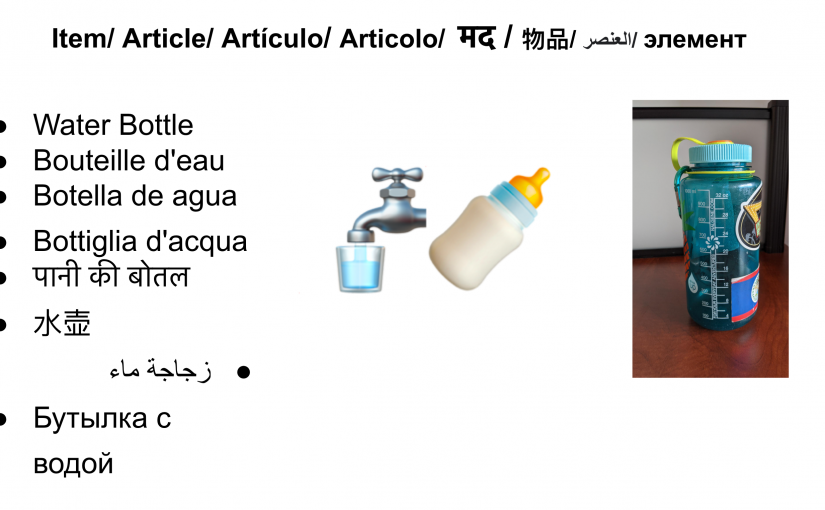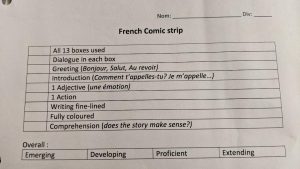It took a while to understand how to effectively utilize the Palladio network, and harness the filtering tools to reveal exactly what I was looking for, but once that was complete, it was clear how much information was available for network analysis. Evoking some of the language from graph theory, it seems as if this exercise was a simple multigraph utilizing a variety of nodes and links (as opposed to its multiplex counterpart). It’s also clear that this was an undirected and unweighted graph, and thus we can only rely on the sum total of links a node has in order to determine the degree of connectivity.
Some statistics and analysis:
There were 27 tracks on the Golden Record, and 21 participants in this curation exercise.
- I shared an average of 4.65 common songs with my peers.
- Marwa and I chose 70% (highest rate of commonality) of the same songs, while Sarah and I shared only 20% (lowest rate of commonality). Between a community of the three of us, for instance it seems we could only agree on a singular song: “Percussion (Senegal)”.
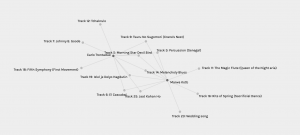
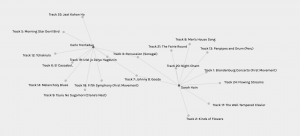
- The song with the highest degree of connectivity was “Percussion (Senegal)” at 76% of participants.
- There are fourteen songs categorized as “Folk” or “Cultural” which makes up roughly 52% of the total music on the Golden Record. Every participant picked at least one Folk style song.
- Of them, Percussion Senegal was chosen an average of 10.64 times (76%), Flowing Stream 9.24 times (66%), Crane’s Nest 7.98 times (57%), Tchakrulo, Types of Flowers, and Panpipes & Drums all 5.88 times (42%), Wedding Song 5.32 times (38%), Azerbaijan Bagpipes, Night Chant, Morning Star, and Izlel de Delyo all 4.62 times (33%), Solomon Panpipes and Pygmy Girl’s Initiation both 3.22 times (23%), and finally Men’s House Song 2.66 times (19%).
- There are fourteen songs categorized as “Folk” or “Cultural” which makes up roughly 52% of the total music on the Golden Record. Every participant picked at least one Folk style song.
- The song with the ‘lowest degree of connectivity’ was “String Quartet No. 3 in B Flat” at 9% of participants.
- There are seven Baroque/ Classical style tracks on the Golden Record’ which makes up 26% of the total music on the Golden Record. Nineteen participants (91%) picked at least one Classical style song.
- Of them, Symphony No. 5 was selected at an average of 3.29 times (47%), Fairie Round 2.94 times (42%), Well Tempered Clavier 2.52 times (36%), Magic Flute 1.82 times (26%), both the Brandenberg and Gavotte at 1.47 times (21% respectively), and String Quartet at 0.7 times (10%).
- There are seven Baroque/ Classical style tracks on the Golden Record’ which makes up 26% of the total music on the Golden Record. Nineteen participants (91%) picked at least one Classical style song.
- Of the Top 10 songs with the highest degrees of connectivity, 50% represent music from the continent of Asia, 30% from North America, 10% from Europe, and 10% from Africa.
- Of these 10 most commonly selected songs, I chose 80% of them in my curated Golden Record. Does this simply reflect my superb music taste? (Definitely not) Is it more of a reflection about my ability to predict what others will choose? Perhaps it indicates something about the criteria I chose to select these songs?
That final statistic prompted me to think further: What criteria did my peers use when selecting their chosen songs into their own Curated Golden Record? I felt it pertinent to review my own criteria. To me, this is the most glaring piece of information the data does not divulge. Despite the commonalities and differences between my peers, there is no indication of why our choices are similar or dissimilar. This is a significant factor to consider: Although we may have selected, or not selected the same song, we may have made this decision based on completely different reasons and criteria. Thus, in spite of the fact that we may have been grouped into certain communities based on our song selection, we may have been grouped there for completely the wrong reasons.
For example, let’s take the rock n’ roll classic Johnny B. Goode by Chuck Berry. I chose to prescribe to a criteria that eliminated the societal significance certain songs had, presumably because these factors would be arbitrary to any extraterrestrial intelligent life that happened upon my Curated Golden Record. Instead, I focused on a thoughtful variety of songs that demonstrated unique and distinct genres, and plethora of instruments, and a certain diversity in location on planet earth. Alternatively, someone may have included Johnny B. Goode because of the immense cultural and societal value it holds; Chuck Berry was one of the first African-American rock n’ rollers, a revolutionary in his own right, and often considered the father of this particular musical genre. Although we may have came to the same selection, our pathways to reach that destination were exponentially different.
Moreover, because there was a 10 song limit to our Golden Record selections, there are underlying implications regarding excluded songs. I suppose the ‘null’ choice can be reflected in the data (neither effectively or positively), but only in comparison to other participants who selected. By not including a song, essentially the data has disallowed you from associating with a given ‘community’. With only 10 songs to pick, I simply had to be ruthless in which tracks I chose to include. I suppose there was also criteria for my non-inclusive music list as well: tracks that sounded somewhat similar or utilized the same instruments, songs of the same genre, songs from the same global area etc. I didn’t pick Panpipes and Drums or Night Chant, for example, but I would have if I had 11 songs to choose!
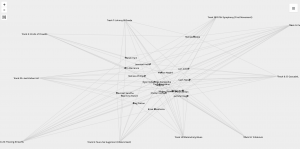
The act of including or omitting in itself is inherently a political act. When I peruse Twitter in between bouts of work, I often notice staunch supporters of the idea that “teachers should never reveal their political positions or ‘indoctrinate’ youth with various political ideologies”. Truthfully, I believe the act of teaching itself is often political – For example, we teach from a mandated curriculum created by a governing body; it’s different from other curricula around the globe. Should we not then develop a universal curricula? It’s often best to tackle these types of issues head one, discuss them, formulate opinions on them, rather than hide from adversity and sweep unwanted conversations under the rug!
Code.org. (2017, June 13). The Internet: How Search Works . Retrieved from https://youtu.be/LVV_93mBfSU
Systems Innovation. (2015, April 18). Graph Theory Overview . Retrieved from https://youtu.be/82zlRaRUsaY
Systems Innovation. (2015, April 19). Network Connections . Retrieved from https://youtu.be/2iViaEAytxw



